Gerard Dillon (1916-1971) Clown and Whirligig Oil on canvas, 76.5 x 127.5cm (30 x 50¼'') Signed Exhibited: 'Gerard Dillon, Canvases and Clowns', Dawson Gallery, 1-24 April, 1965 Cat. No. 1. We are grateful for Karen Reihill for he kind assistance with the cataloguing of the present work. The circus was a popular subject matter for artists in the late 19th and early 20th centuries, drawn to the unusual characters that inhabited this world. The visual spectacle offered artists, such as Dillon, ready-made subject matter full of colour and dynamism. The natural element of performance resulted in compositions of powerful imaginative force, creating an exciting world that the viewer could partake in. While many characters from the circus were portrayed, the clown became a particularly popular figure for artists. By the end of the 19th century this fascination had developed into the theme of the sad clown. They were portrayed as characters full of pathos, paradoxically striving to entertain and make their audience laugh, while at the same time suffering from melancholy and alienation. The compositions often hinted at the darker aspects of humanity, our ability to take enjoyment out of the belittlement of others. The circus attracted individuals who existed on the margins, not fully accepted within traditional society. A reality, which was understandable to artists of most periods. Clowns are very common in Dillons work particularly from the 1950s onwards, depicting them in numerous forms, such as commedia dellarte character of Pierrot in Clown with Bird Canvas (1960) in the collection of IMMA, or the more pensive figure in Clown Thinking, sold in these rooms in 2018. Works of this period are often associated with the traumatic events occurring simultaneously in Dillons personal life. Through their darker colour palette and somewhat haunting surreal compositions, they are imbued with a sense of desolation and sorrow. In this present lot, Dillon does not follow this theme exclusively, his depiction of the clown, is one in the act of performing for a crowd, albeit outside of the visible picture plane and as such we the viewer, become the literal audience for the scene. His arms raised, holding a baton in one hand and the whirligig, a literal spinning wheel of colour to his right, creates a more celebratory atmosphere. The whirligig, a toy powered by the wind, was a favoured pastime of children. This sense of dynamism is continued into the figure of the clown, who is looking both at straight at us and at the same time, in the manner of Janus, turning his head to one side. In this work the costume, diverging from the pure white of Pierrots, is reminiscent of the more traditional 19th century circus clown, with the wide ruffled collar, top hat and patchwork suit. His face is painted completely white, with a just a hint of red on his lips. The looser handling of paint, applied in broad strokes of block colour, creates a pseudo-naïve style. There is a deliberate lack of detail in the face of the figure, strikingly different to the powerful gaze of the character in Clown Thinking. The features are hidden from us; masked behind the white paint, he is playing a role, a full embodiment of his dramatic persona. Niamh Corcoran, November 2019 Gerard Dillon (1916-1971) Clown and Whirligig Oil on canvas, 76.5 x 127.5cm (30 x 50¼'') Signed Exhibited: 'Gerard Dillon, Canvases and Clowns', Dawson Gallery, 1-24 April, 1965 Cat. No. 1. We are grateful for Karen Reihill for he kind assistance with the cataloguing of the present work. The circus was a popular subject matter for artists in the late 19th and early 20th centuries, drawn to the unusual characters that inhabited this world. The visual spectacle offered artists, such as Dillon, ready-made subject matter full of colour and dynamism. The natural element of performance resulted in compositions of powerful imaginative force, creating an exciting world that the viewer could partake in. While many c
Gerard Dillon (1916-1971) Clown and Whirligig Oil on canvas, 76.5 x 127.5cm (30 x 50¼'') Signed Exhibited: 'Gerard Dillon, Canvases and Clowns', Dawson Gallery, 1-24 April, 1965 Cat. No. 1. We are grateful for Karen Reihill for he kind assistance with the cataloguing of the present work. The circus was a popular subject matter for artists in the late 19th and early 20th centuries, drawn to the unusual characters that inhabited this world. The visual spectacle offered artists, such as Dillon, ready-made subject matter full of colour and dynamism. The natural element of performance resulted in compositions of powerful imaginative force, creating an exciting world that the viewer could partake in. While many characters from the circus were portrayed, the clown became a particularly popular figure for artists. By the end of the 19th century this fascination had developed into the theme of the sad clown. They were portrayed as characters full of pathos, paradoxically striving to entertain and make their audience laugh, while at the same time suffering from melancholy and alienation. The compositions often hinted at the darker aspects of humanity, our ability to take enjoyment out of the belittlement of others. The circus attracted individuals who existed on the margins, not fully accepted within traditional society. A reality, which was understandable to artists of most periods. Clowns are very common in Dillons work particularly from the 1950s onwards, depicting them in numerous forms, such as commedia dellarte character of Pierrot in Clown with Bird Canvas (1960) in the collection of IMMA, or the more pensive figure in Clown Thinking, sold in these rooms in 2018. Works of this period are often associated with the traumatic events occurring simultaneously in Dillons personal life. Through their darker colour palette and somewhat haunting surreal compositions, they are imbued with a sense of desolation and sorrow. In this present lot, Dillon does not follow this theme exclusively, his depiction of the clown, is one in the act of performing for a crowd, albeit outside of the visible picture plane and as such we the viewer, become the literal audience for the scene. His arms raised, holding a baton in one hand and the whirligig, a literal spinning wheel of colour to his right, creates a more celebratory atmosphere. The whirligig, a toy powered by the wind, was a favoured pastime of children. This sense of dynamism is continued into the figure of the clown, who is looking both at straight at us and at the same time, in the manner of Janus, turning his head to one side. In this work the costume, diverging from the pure white of Pierrots, is reminiscent of the more traditional 19th century circus clown, with the wide ruffled collar, top hat and patchwork suit. His face is painted completely white, with a just a hint of red on his lips. The looser handling of paint, applied in broad strokes of block colour, creates a pseudo-naïve style. There is a deliberate lack of detail in the face of the figure, strikingly different to the powerful gaze of the character in Clown Thinking. The features are hidden from us; masked behind the white paint, he is playing a role, a full embodiment of his dramatic persona. Niamh Corcoran, November 2019 Gerard Dillon (1916-1971) Clown and Whirligig Oil on canvas, 76.5 x 127.5cm (30 x 50¼'') Signed Exhibited: 'Gerard Dillon, Canvases and Clowns', Dawson Gallery, 1-24 April, 1965 Cat. No. 1. We are grateful for Karen Reihill for he kind assistance with the cataloguing of the present work. The circus was a popular subject matter for artists in the late 19th and early 20th centuries, drawn to the unusual characters that inhabited this world. The visual spectacle offered artists, such as Dillon, ready-made subject matter full of colour and dynamism. The natural element of performance resulted in compositions of powerful imaginative force, creating an exciting world that the viewer could partake in. While many c

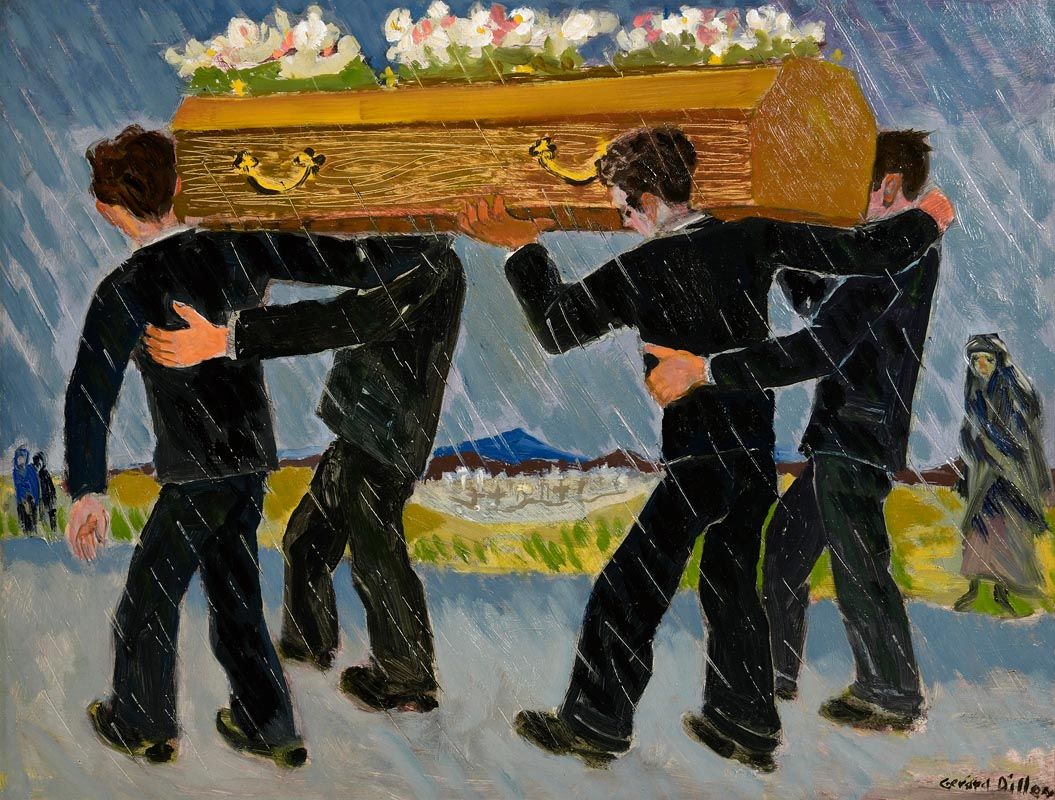

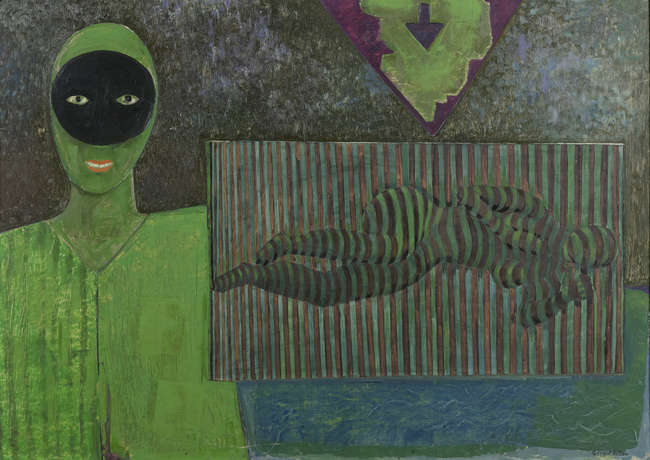
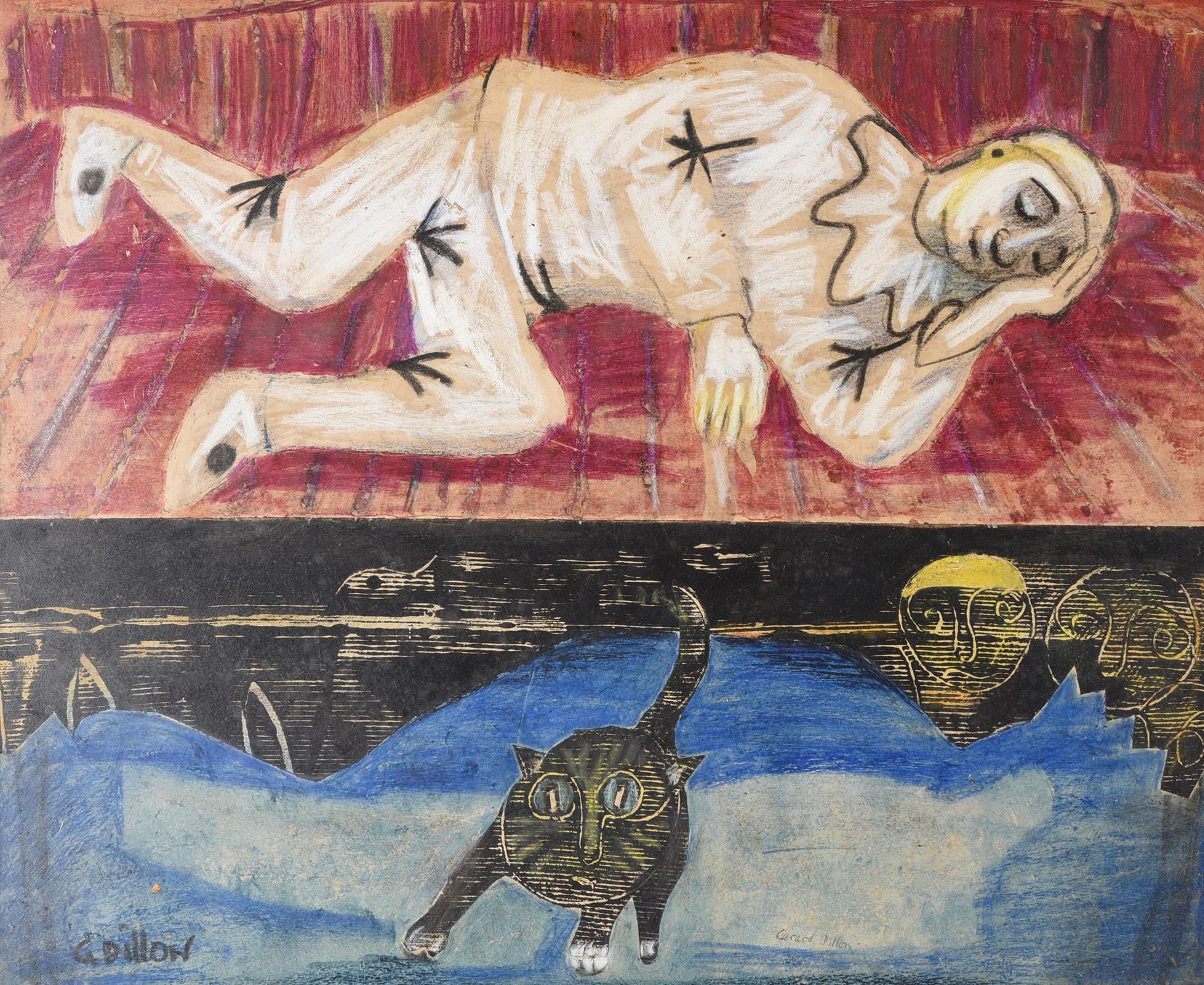
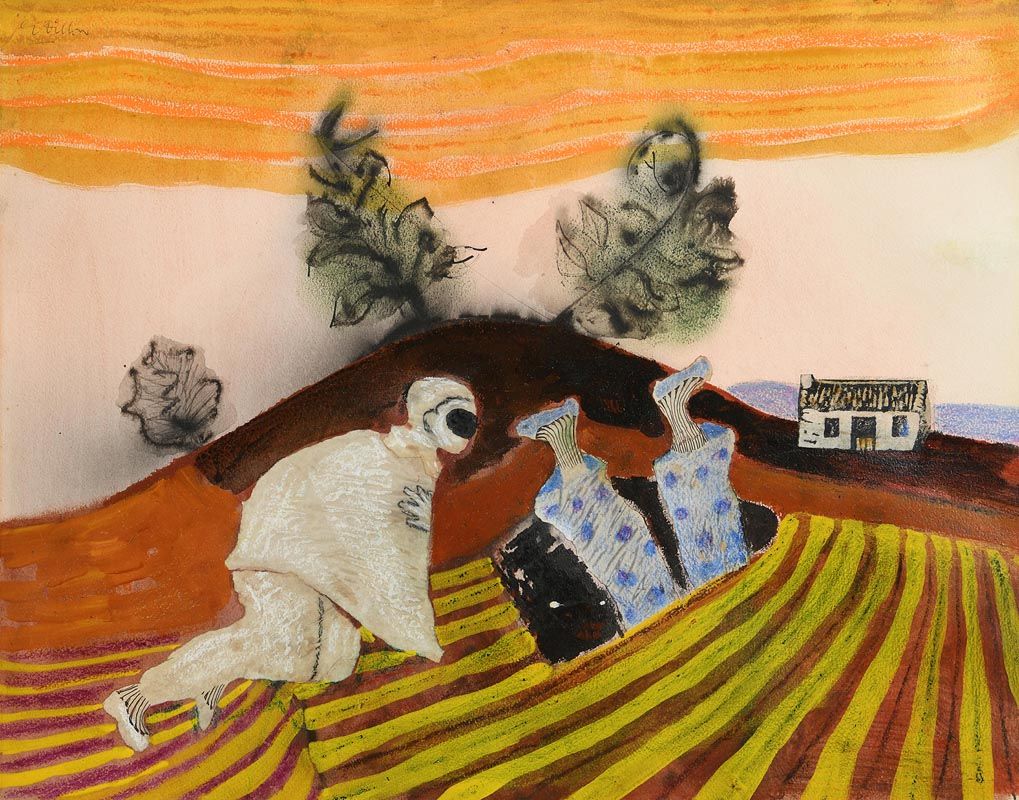

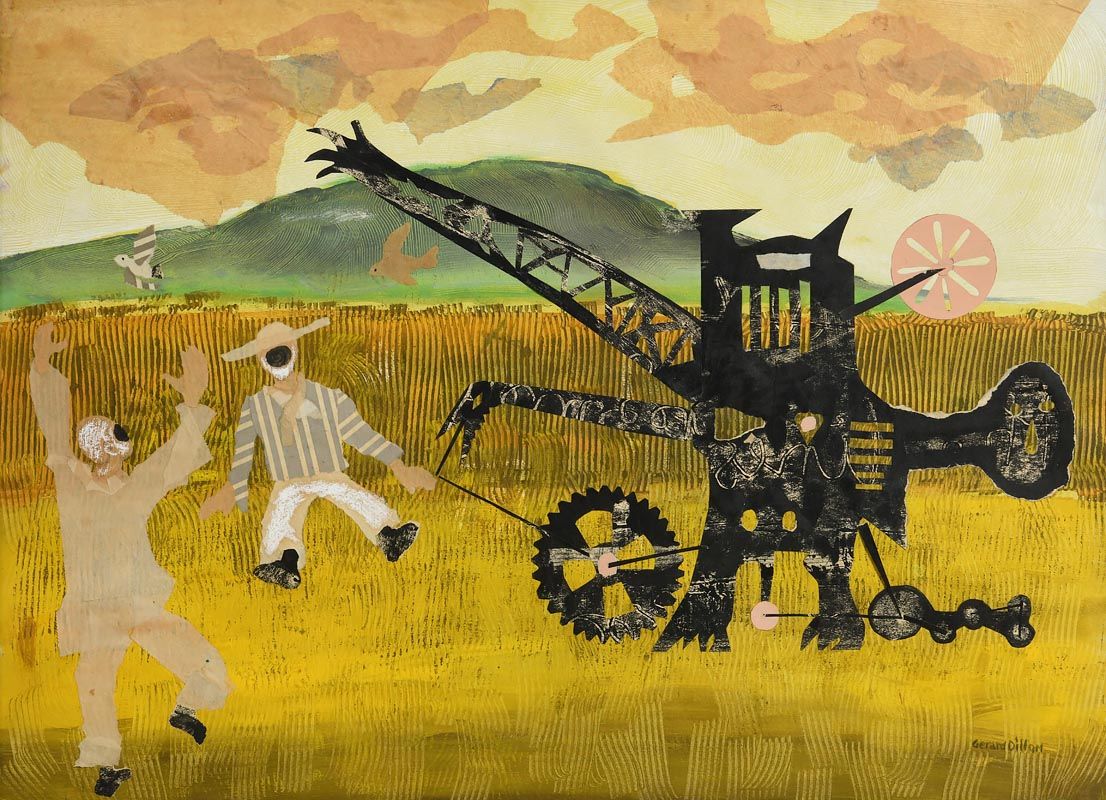

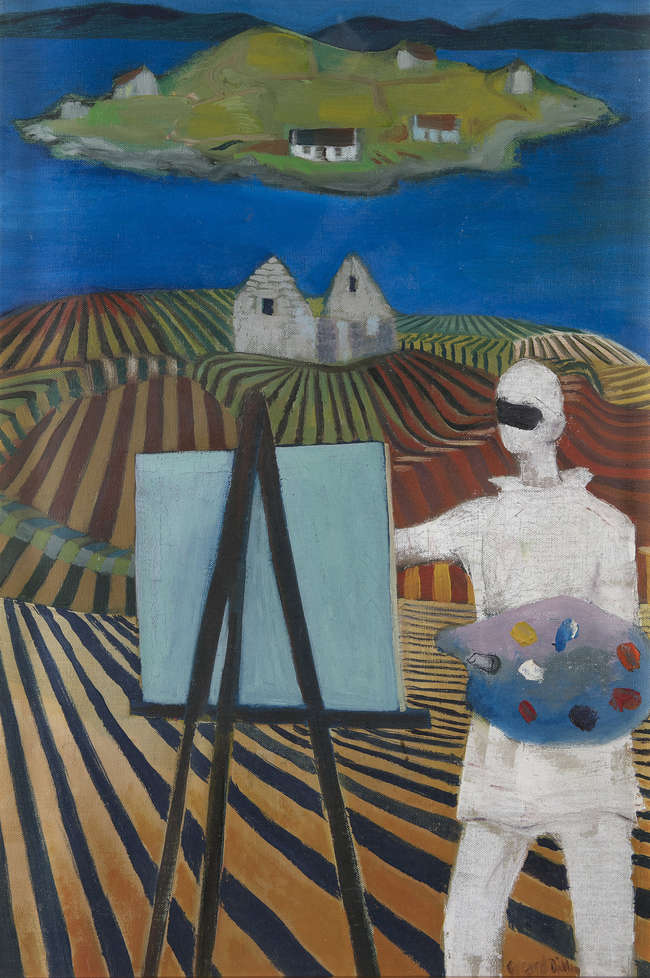



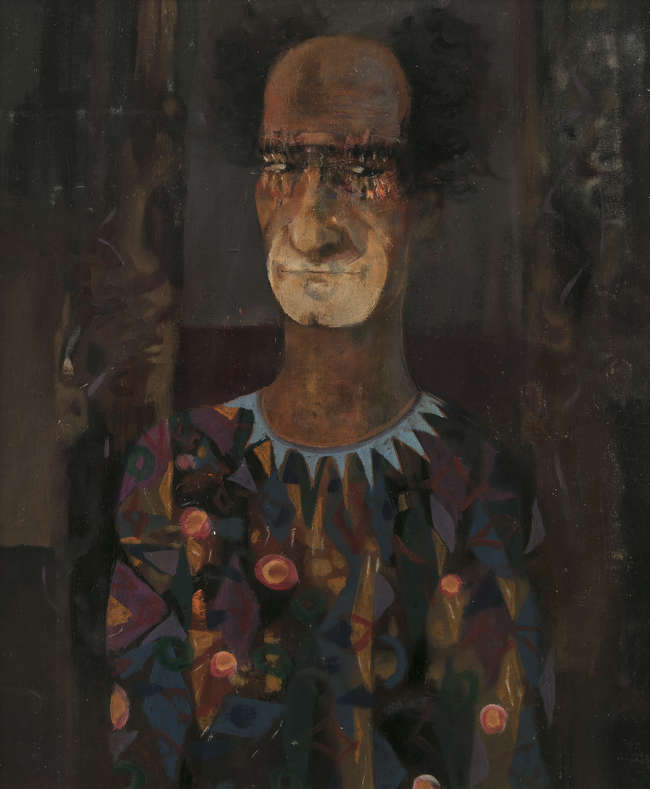
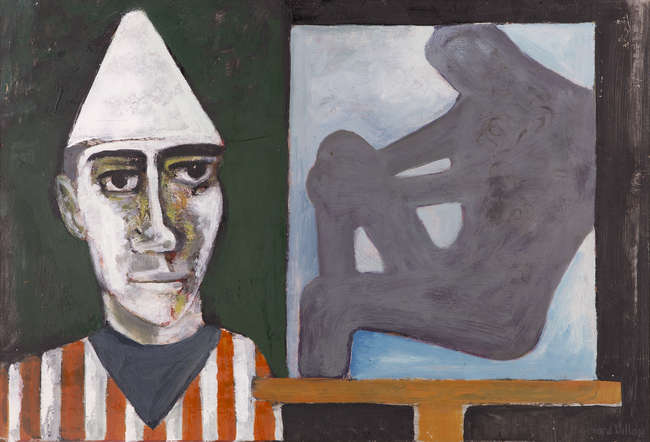
Testen Sie LotSearch und seine Premium-Features 7 Tage - ohne Kosten!
Lassen Sie sich automatisch über neue Objekte in kommenden Auktionen benachrichtigen.
Suchauftrag anlegen